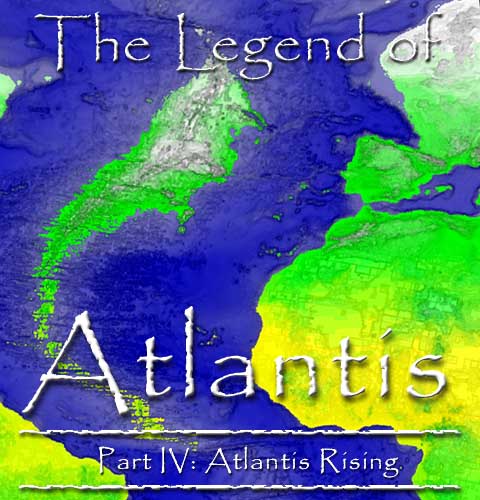
Editorial
|
Press Releases
|
Book Reviews
|
Fragments
Effigy Mounds II
|
Sea Serpents IV
|
Atlantis IV
Register
for our new Hall of Records Newsletter!
Questions? Comments? Suggestions? Advertising? Press Releases?
Contact us!
The Legend of Atlantis Part I: Atlantis in History
Part II: The Antediluvian World
|
Part III: Edgar Cayce's Atlantis
Atlantis: Retrospective
|
Atlantis: The Theories
|
Atlantis: The Azores
|
Atlantis Rising
Atlantis Links
|
Atlantis Books

las, Atlantis! Let us sit upon the ground and tell sad stories of the death of empires. Utterly wicked, yet remembered as a paradise in the
myths and legends of the descendants of those whom she had once tried to enslave. Greatest of Earth's mysteries, she lies sleeping upon the
abyssal Atlantic plain, still the source of romantic speculation, fearful awe, and the unspoken dread that she may one day rise again.

It's been an epic journey over the past year, and during our voyage of discovery to unlock the secrets of legendary Atlantis, we have gone
places that few would have imagined would have any relevance to a study of this ancient lost empire. From the classical Platonic references, to
the antediluvian world that was destroyed in the Bible to the mystic visions of Edgar Cayce, we have analyzed the many threads that make up the
tapestry of myth and history that is the legend of Atlantis. As we conclude our study of the legend of Atlantis, let us review what we have
uncovered in our year-long voyage of discovery:

In
Part I
of our series on legendary Atlantis, we explored Plato's voluminous tales of the ancient island empire. One of the primary
sources of information we have on Atlantis is Plato's Timaeus, one of two works of Plato that mentions Atlantis. Timaeus is the
story of an Athenian
Greek philosopher named Timaeus who was the keeper of an oral tradition involving Atlantis. This oral tradition had started hundreds of
years earlier when Solon, a
famous Athenian traveler, poet, and lawgiver, had met an Egyptian priest of the goddess Neith while traveling in the Sais district in lower Egypt. Solon,
who had gone to Egypt to impress the Egyptians with the wisdom of the Greeks, found himself greatly outmatched by the wisdom of the Egyptians,
to whom the Greeks were as children by comparison.
The oral traditions of the Greeks, Solon was to learn, even though they were centuries old, were relatively new compared to the traditions
of the Egyptians, whose roots stretched back thousands of years. However, Solon also learned from the Egyptian priest that the Athenian
Greeks had actually been in existence before the Egyptians — 9000 years before even Solon's time, which was around 600 b.c. — but
their civilization had been wiped out after a war with an ancient antediluvian empire known as "Atlantis".
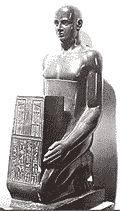
|
|
A statue of Chief of Physicians, Psammetik-seneb, originally installed in Sais. Image from
Tour Egypt: Sais
|
Athens, Solon discovered from the priest, had at at that time (ca. 10,000 b.c.) been one of the most culturally and militarily superior
countries on Earth, greater even than Egypt, the priest describing it as "first in war and in every way the best governed of all cities".
More importantly, Athens at that time had stood as the last line of defense against the imperialist aggression of the Atlantean Empire,
which had threatened to conquer Egypt, Athens, and all of Europe and Asia.
The priest described Atlantis as a vast continent that lay in the Atlantic Ocean west of the Pillars of Hercules, that "was larger than Libya
and Asia put together". Atlantis at that time was actually made up of several islands that were ruled over by the empire along with a
substantial amount of North Africa and Europe. Not satisfied with this, Atlantis sought to conquer the entire world. All but Athens
sued for peace, leaving Athens to stand alone against the awesome might of the Atlantean armed forces. However, Athens "shone forth, in the
excellence of her virtue and strength, among all mankind", not only repelling the Atlantean onslaught, but driving them out of Europe and
North Africa altogether. Badly beaten, the Atlantean navy limped back to their home ports. Then, in a single day and night, both Athens and
Atlantis slipped beneath the waves in an incredible cataclysm. This great destruction of Atlantis and Athens was most likely a part of
the Great Flood that was also recounted in the Bible as the destruction of the antediluvian world.

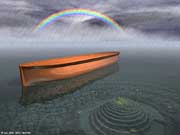
|
In
Part II
of our series on legendary Atlantis, we examined in detail the biblical account of the antediluvian world in order to gain further insight into
why it was destroyed. Plato's Timaeus describes the Atlanteans' attempt to conquer the world and their subsequent destruction, but gives
no insight into either how both they and the Athenians were destroyed "in a single day and night of misfortune", or why. Timaeus does
state that the destruction of Atlantis and of Athens occurred at the same time as a great flood, but no details were given regarding this
flood, other than the fact that it was exceptionally destructive as compared to previous flood events, of which apparently there have been many.
The Bible, however, makes it clear that the antediluvian world was destroyed by a Great Flood due to the extreme wickedness of mankind, to
the point where God regretted ever having created mankind. He then sent the
Flood to wipe out all but a chosen few that He saved in an ark, to begin afresh. It is reasonable to assume that the Great Flood described in
Timaeus and in the Bible were one and the same, though hard evidence to prove it beyond a reasonable doubt is not available, so we
must, at this point, go on faith.
There is more in the Bible about the antediluvian world than just the Flood, however. Enigmatic passages early in Genesis and parallel
descriptions in related literature such as The Book of Enoch describe the descent
of angelic beings from heaven, angels that, though they initially came to do good, ended up doing more harm than good, and in the process
became corrupted. These angels broke God's edicts and interacted directly with mankind, giving them gifts of technology and intermarrying with
human females, their resulting offspring being gigantic in stature. The giant offspring of these fallen angels
were utterly wicked and, according to documents related to the Bible, ate so much that they ran out of food, then turning to cannibalism and
eating the normal-sized humans that had formerly been feeding them.
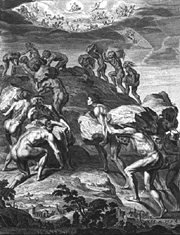
|
|
"The Giants Attacking Heaven" by Bernard Picart (1673-1733). In the Greek myths, Zeus and other children of the Titans made war on their
Titan forebears, who had been ruling unjustly in a battle known as the
Titanomachy.
Though Zeus and co. overthrew the titans, the titaness Gaia gave birth to the
giants
in order to take revenge. The giants made war on Zeus and the heavenly gods in a battle known as the
gigantomachy, in which the giants were
utterly defeated. The giants of the Bible may have attempted to overthrow heaven as well.
Image from
Greek Mythology Link: Giants
|
These wicked giants in time became masters of the art of war, using the gifts of technology given to them by their fallen angelic fathers to
make war on normal humans, to the point where "the earth also was corrupt before God, and ... filled with violence".
World war, just like Plato described it in Timaeus, was raging in the world before the Flood. Out of patience with the fallen angels and
their giant offspring, the Nephilim, God sent the archangels to destroy them both. The archangels accomplished this, according to the
apocryphal literature, by setting the giants against each other in a massive civil war — which may have been the war between Atlantis and
Athens that Plato described — and hurling rocks down upon the evil angels that had created them, imprisoning these fallen angels in the
deepest places of the earth — the abyssal plains beneath the oceans. This would explain the sudden destruction that was visited upon the
Atlanteans and Athenians — both were destroyed by massive asteroids that were thrown down from heaven. God then sent the Flood to wipe the
slate clean, in the process utterly destroying the antediluvian world, and
trapping the fallen angels in a watery prison, where they wait to this day
(cf.
Rev. 9)
.
Unfortunately, Atlantis is not named in the Bible but, as we have seen, the conditions in the antediluvian world described in the Bible and
in Timaeus are strikingly similar. Though unlike the Bible, Plato's Timaeus contains no specific information about the world
before the Flood, his other work on the
subject, Critias, goes into that subject in detail. Interestingly, the story that comes forth from Critias is also strikingly
similar to the story put forth in the Bible: divine beings came down from heaven and intermarried with human females, giving birth to a race
of giants. Another point of collusion between Plato and the Bible is the fact that rule over Earth was divided up amongst these divine beings
who came down (or were thrown down) from heaven, so that each country has its own fallen ruler, to this day.
The region of Atlantis was given to the deity whom the Greeks called Poseidon, the ruler of the sea. Poseidon married a human female, who gave
birth to five pairs of giant twins. Poseidon gave these giants, or "titans" as the Greeks called them, rule over the islands of Atlantis and
all of the normal-sized humans that inhabited them. However, over time, these titans intermarried too often with the normal humans and started
to take on their human emotions, such as greed, envy, and lust for power. They then began to act out on these new emotions, making war on their
neighbors, seeking to expand their control to parts of Earth that had been ceded to other deities, and soon world war broke out. Zeus, the
high god of the Greek pantheon, however, stepped in and put a stop to it, just as God had done in the Hebrew scriptures and related writings.
Zeus, it is intimated, then destroyed wicked Atlantis, just as God had destroyed the antediluvian world, but exactly how he did this is not
stated in Critias.

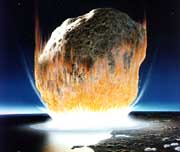
|
In
Part III
of our series on legendary Atlantis, we focused in on the third most influential writings on the subject of Atlantis, the visions of the
controversial modern "prophet", Edgar Cayce. Cayce taught that man has been around since 10,500,000 b.c., and that man had not been
originally "created", but was sort of "materialized", or "projected" into being by spiritual "entities" that willed him into existence. This
"projection" probably did not take place instantaneously, but probably over thousands, even millions of years of evolution. Man was
first created as five different races, apparently as genetically modified primates, perhaps the DNA of an ape combined with that of a lion,
for example. These early proto humans were clearly imperfect, being formed in various sizes and shapes, often with animal-like characteristics
such as feathers, scales, or even tails, some combinations being quite beautiful and useful, others being quite bizarre. This version of
mankind, which was apparently hermaphroditic, was used as slave labor by the fallen angels to use and abuse as they wished. The fallen angels
also gave this early form of man technology, including metalworking, knowledge of music and, of course, warmaking.
Some time later, the most high God, which Cayce identifies with the God of the Bible, created his own version of man, that was apparently
created to replace the previous, inferior versions of man. Cayce identifies this new type of man with the Adam of the Bible, who was probably
the first homo sapiens. This new
"Adam-class" human was different in several ways from the previous versions. For one, he was of a height and build that proved to be more
efficient than the previous, "pre-Adamic" forms, which apparently
tended to be either giants or dwarfs. Also, Adam was given a separate, female version, unlike the "pre-Adamic" races which were hermaphroditic.
This method, according to Cayce, made the new type of human more successful than the previous forms. Though Cayce does not say specifically
what happened, it appears that this new form of man, the race of Adam, did not get along well with the previous forms of humanity. This was
probably because the pre-Adamites feared, rightly, that Adam had been created to replace them. Regarding the Fall of mankind and
the entering of sin into the world, a study of Cayce in the context of the Bible and related texts appear to point to the idea that the Fall
was as a result of Adam and Eve interbreeding with
these previous, inferior versions of mankind whom God had intended them to replace. As a result, Adam, Eve and their seed were corrupted. Ever
since, there has been warfare between the two "seeds", that of God and the fallen angels, the seed of the woman and the seed of the serpent.
It appears also that Atlantis may have been the location of the Garden of Eden, where Adam and Eve were created, though Cayce's
readings are not clear on this subject.
In Cayce's reading of history, despite their fall from grace, the descendants of Adam for the most part kept themselves genetically separate
from the wicked creations of the fallen angels. As a result, Earth became divided up basically between the two groups, which Cayce referred
to as the Sons of the Law of One and the children of Belial, respectively. The Sons of the Law of One and the children of Belial both lived
in Atlantis, and for a time, apparently, the Sons of the Law of One, who worshipped
the one God, kept the children of Belial, who worshipped idols, under their sway. Together they built a very powerful civilization, based upon
the high moral and ethical teachings of the Sons of the Law of One, and high technology that both groups co-developed using crystals that
harnessed the energies of the sun and of nature.
However, though the Sons of the Law of One wanted to
use these technologies for the betterment of mankind, the children of Belial wanted to use them to conquer and enslave mankind. The Sons of
the Law of One refused to let them do this, so the children of Belial rebelled from those of the Law of One and began building their own
weapons from the crystal technology. They developed the destructive capacity of the technology to the point where they could
use it to tap into Earth's volcanic and tectonic forces, which they used to inflict earthquakes and similar disasters upon their enemies.
However, the side effect of this technology was that it weakened the volcanic pressure under the islands of Atlantis to the point where the
islands began to experience massive earthquakes, and much of the continent of Atlantis sank beneath the
waves, leaving behind five large islands where once there was one large continent. This was the First Great Destruction of Atlantis, around
50,000 b.c.
After the First Great Destruction, all Atlanteans, both of the Law of One and Belial, began to work together again for the common good.
Thousands of years passed, however, and the lust for power of the children of Belial began to return as the memories of past disasters
had faded over time. Once again the children of Belial rebelled and built weapons to destroy their enemies, and once again more of the
islands of Atlantis went into the sea except for the island of Poseid, just west of the Pillars of Hercules, where the Sons of the Law
of One still lived. This was the Second Great Destruction, around 10,500 b.c.
Even after the destruction of most of the continent of Atlantis, the children of Belial continued to use the Atlantean technology to build
weapons, so the Sons of the Law of One wisely decided
that it was time to emigrate from their doomed island. The Atlanteans set up colonies all around the Atlantic rim, including what is now
Peru, the Yucatan, America's desert southwest, the Pyrenees Mountains of Spain and France and of course Egypt, where the largest contingent
went. There in Egypt, as the children of Belial continued arming themselves in an attempt to conquer the world, the Sons of the Law of One began
to set up institutions towards the betterment of mankind. Hospitals and related facilities offered advance physical and psychological healing,
but once again the children of Belial turned these things to evil, using the psychological, chemical, and technological methods that the
Sons of the Law of One had developed to heal mankind to instead enslave mankind. It was at this time, with the world continuously at war and
the last island of Atlantis slowly sinking, that Noah was likely called out to build the ark.
Cayce's visions, like the Platonic narratives, seem to argue for a more limited Flood, which did not wipe out all mankind. In fact, many
Flood stories do not describe a complete destruction of mankind save a few saved in an ark, but simply of a massive disaster that broke down
civilization all over the world. Yet, the Bible clearly states that all but those on the ark perished. Time will tell which is right.
Before we draw our final conclusions on the facts and theories about Atlantis and the antediluvian world, let us first determine the actual
location of Atlantis. This will help us determine both the facts about Atlantis, and of its larger meaning for mankind, both in understanding
our past, and our future.

Many have conjectured on the location of Atlantis. Was it in the middle of the Atlantic, "west of the Pillars of Hercules", as Plato and Cayce
had posited, or was it in a myriad of other places that have been suggested over the last few decades as the increase in knowledge and in travel
has expanded man's ability to seek out and explore ancient civilizations? North America, Central America, South America, Cuba, the Yucatan,
ancient Crete, even island chains in the Pacific have been posited as the sunken remains of fabled Atlantis.
Atlantis - The Lost Continent Finally Found
has a very thorough
checklist
covering all of the places theorized as the location of Atlantis. Though much of the analysis in this site and some other books and websites
disagree with much of what we have found in our analysis of Atlantis and its probable location, let us go through some of the most popular
destinations and see what interesting ideas are fulminating out in the controversial field of Atlantean research:

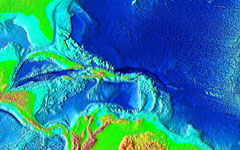
|
|
A false-color satellite photo showing actual extent of the Caribbean and surrounding islands beneath sea level. A lowering of the sea
level of a few hundred feet would expose a large amount of land in the Caribbean, making it more of a small continent than a collection
of islands.
Click here
to see a full-sized version.
|
One of the most popular and well-supported theories for the location of Atlantis is in the Caribbean. Edgar Cayce believed that the Caribbean
Islands are the partly drowned remnants of one of the islands that the Atlanteans emigrated to after the main
continent of Atlantis began to suffer the destructive effects brought on by the wars of the children of Belial. This was around the beginning
of the Ice Age, around 50,000 b.c., when most of this area was indeed above water. At this time the islands of the Caribbean, along with Cuba,
were all part of a larger land mass that was connected with Central America via the Yucatan peninsula, and
possibly with North and South America as well. As Shirley Andrews explains in
Atlantis: Insights from a Lost Civilization,
During the most recent Ice Age, from 50,000 B.C. until 10,000 B.C., so much water from the oceans was incorporated into the snow and ice of
the glaciers, that they grew to be a mile-high in some places. As a result, the Atlantic Ocean was approximately 350 feet lower than today
and most of the continental shelves were above the surface. The continental shelves extend out as far as two hundred miles from the present
shore lines of America and Europe. Land areas in the North Sea, the English Channel, as well as much of the Caribbean area were also above
the surface of the ocean during the last half of the Ice Age. Atlanteans moved to all of these areas, for the land was more stable than the
Atlantic Ridge. Since the ocean was lower, additional shorelines were exposed, so islands were larger and therefore closer together. It
didn't require a large, complicated boat to sail from one place to another. The Bahama Islands consist of about seven hundred small islands
and cays. They extend from fifty miles east of Palm Beach, Florida for approximately 760 miles southeast in the direction of Haiti. When a
large amount of ocean water was incorporated in the glaciers during the Ice Age, the entire region, which is known as the Bahama Bank, was
above sea level. It is clearly visible on
a map which depicts the ocean floor.
During the Ice Age, the Yucatan peninsula of Mexico stretched
out nearly to Cuba, which was a larger island than today, and the Key West chain of islands was a land bridge that stretched almost to the
northern coast of Cuba. A long mass of land, with only two or three breaks for rivers, ran from Jamaica, across what are now the Lesser
Antilles Islands and continued all the way to Venezuela. Atlanteans thrived in all these areas.1
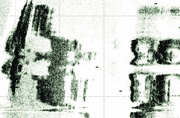
|
|
One of the "sunken city" images taken off the coast of Cuba by Advanced Digital Communications, a company that had been hired by
the Cuban government to search for oil deposits and sunken ships off the southwest coast of Cuba. This image clearly shows manmade
structures some 2,200 feet below the ocean surface, proving that inhabited land masses have indeed sunk in the past as Atlantis is
said to have done.
Click here
to read more about this critical discovery.
|
In July of 2000, as discussed in detail in the Fragments article,
Atlantis Off Cuba?
earlier in this issue, a commercial expedition found several large, manmade structures 2,200 feet below the surface of the
Gulf of Mexico, southwest of Cuba, near the Yucatan Peninsula. This was approximately where Cayce predicted such structures would be found
around the turn of the millennium, around which time he believed Atlantis would begin to rise again. Other structures that support Cayce's
belief that the Caribbean was once a major center of Atlantean habitation include the controversial "Bimini Road", that was found in 1968
near the island of Bimini, an area which Cayce identified as the place where many
Atlanteans fled after the first destruction, ca. 50,000 b.c.2
More support for the "Atlantis in the Americas" theory has been developed by authors Ivar Zapp and George Erickson, who believe Atlantis was
located around the area of the Caribbean and Central America. Besides the highly developed architecture of the Inca, the Maya, and other
ancient cultures of the Americas, one of the more interesting proofs of an ancient, sophisticated maritime civilization that Zapp investigated
was the discovery of hundreds of stone spheres in the Diquis Delta region of Costa Rica. These stones were precisely machined to within a
thousandth of an inch of perfect sphericity,
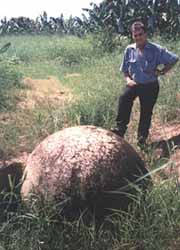
|
|
Ivar Zapp standing astride one of the hundreds of stone spheres dotting the landscape around the Diquis Delta region of Costa Rica.
Authors Zapp and Erickson believe that these stone spheres, which point to major neolithic sites around the world, sat at the heart
of a major maritime culture.
Image from
Atlantis in America.
|
measured up to nine feet in diameter, and weighed as much as twenty tons. Zapp, a professor of architecture, decided to accept their existence,
unlike his archaeological predecessors who dismissed the stone spheres as "out of context" and tried to forget them as they did not agree with
their preconceived notions of the area's history. Zapp had initially visited the area of
Costa Rica on a field trip with some of his students in order to investigate the purpose of the stones, and they discovered that these
enigmatic stone spheres were actually arranged in patterns that appeared to point to other megalithic structures around the world.
Professor Zapp and his students first studied the layout of the spheres that remained in situ [and] found that, in most cases, the
stones were arranged in groups of threes forming a triangular configuration. Ivar noticed that an axis line formed between two major groups
of the spheres was oriented to the magnetic north pole, indicating that the builders had a knowledge of the magnetic compass.... Using a
globe ... Ivar found that the 19 degree southwest inclination of the line that intersected [certain spheres] projected from the Palma Sur
site in the Diquis Delta leads to Cocos Island, to the Galapagos Islands, and then to Easter Island. [Another line] leads to the straits
of Gibraltar, and if projected southwest, leads to the Marquesas. In another group the axis leads to the Great Pyramid of Giza. In another,
it leads to Stonehenge. In every case, the megaliths of Costa Rica pointed to great megaliths of distant lands and
islands.3
Interesting reports of ancient Atlantean crystal technology in the Caribbean also surface from time to time.
Geoffrey Keyte in
The Millennium Matters' interesting website
describes a strange event that occurred in the early 1970s when a man by the name of Dr. Ray Brown went scuba diving near the Bari Islands
in the Bahamas. During one of his dives, he came across a pyramidal shape with mirror-smooth surfaces, and went to investigate:
Swimming around the capstone, which Brown thought might have been lapis lazuli, he discovered an entrance and decided to explore inside.
Passing along a narrow hallway, Brown finally came to a small rectangular room with a pyramid-shaped ceiling. He was totally amazed that
this room contained no algae or coral growing on the inner walls. They were completely spotless! In addition, though Brown had brought
no torch with him, he could nevertheless see everything in the room with his normal eyesight. The room was well lit, but no direct light
source was visible. Brown's attention was drawn to a brassy metallic rod three inches in diameter hanging down from the apex of the center
of the room and at its end was attached a many-facetted red gem, which tapered to a point. Directly below this rod and gem, sitting in the
middle of the room, was a stand of carved stone topped by a stone plate with scrolled ends. On the plate there was a pair of carved metal
bronze-colored hands, life-sized, which appeared blackened and burnt, as if having been subjected to tremendous heat. Nestled in the hands,
and situated four feet directly below the ceiling rod gem point, was a crystal sphere four-inches in diameter. Brown tried to loosen the
ceiling rod and red gemstone but neither would move. Returning to the crystal sphere, he found, to his amazement, that it separated easily
from the bronze hand holders. With the crystal sphere in his right hand he then made his way out of the pyramid. As he departed, Brown felt
an unseen presence and heard a voice telling him never to return! Fearing, rightly, that his unusual prize might be confiscated as
salvage-treasure by the American Government, Dr. Brown did not reveal the existence of his strange crystal sphere, nor did he relate his
experiences until 1975, when he exhibited his crystal for the first time at a psychic seminar in Phoenix. Since that time, the crystal
sphere has made only a very few public appearances but on each occasion people who have seen it have experienced strange phenomena directly
associated with it.4
Psychics are of course fascinated with Atlantis and the Atlantean crystal technology. Shirley Andrews describes in
Atlantis: Insights from a Lost Civilization
the visions of two psychics who explored the area around Bimini that are strikingly similar to the biblical account of the fallen angels and
how they interacted with mankind. Their visions referred specifically to the Atlantean women who had fled to what is now the Bimini area:
Two psychics, who assisted Dr. Zink in his research in Bimini, related that highly evolved, loving extraterrestrial beings from the Pleiades,
perceiving the spiritually advanced residents of Murias, joined the thriving commercial and religious community and assisted with the
construction of temples and buildings. The psychics relayed that the highly evolved priestesses who presided over the unique temple,
developed an extensive variety of invaluable medicinal potions derived from flowers, herbs and other vegetation for use as healing
remedies for those who came for help and advice.5
This is particularly good evidence backing up the Bible's and the Book of Enoch's descriptions (as we saw in
Part II
of this series) of how fallen angels had interacted with women
before the Flood, as it specifically mentions the fact that these beings had taught mortal women the knowledge of how to use medicinal herbs
for healing and other uses, just the fallen angels had done. Krista M. Baker explains in "Watchers/Nephilim (Naphidim)", "Once they reached the
earth ... the Angels then taught women charms, enchantments, the cutting of roots, and the knowledge of plants."6
As a side note, these beings described themselves as being from the
Pleiades,
a common place that UFO aliens are believed to come from, but that is a story for a different time.
Despite these amazing discoveries the Caribbean, though certainly an important part of Atlantean history, was not Atlantis. It was instead
either one of the areas that the Atlanteans fled to after the First Great Destruction of Atlantis, around 50,000 b.c., or possibly one of the
western islands mentioned by Plato that were under Atlantean rule from the beginning, but not actually part of Atlantis proper. In either case,
the bulk of these islands also sank beneath the waves at the end of the last Ice Age (around 10,000 b.c.), forcing the Atlanteans to emigrate
further west. Cayce (and others) believe that the red races of the Americas are actually descendants of these Atlanteans who intermarried
with the native inhabitants who preceded them, leaving behind a legacy of magnificent architecture and amazing astronomical and calendrical
knowledge, among other things. And what of the crystal "firestones" that the Atlanteans left behind on these islands, one of which may have
actually been seen? Some believe they are
the cause of the many strange occurrences and disappearances in the
Bermuda Triangle,
which encompasses this entire area. More on this in future articles also.

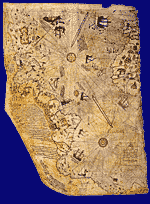
The Piri Reis map.
Piri Reis was a famous admiral of the Turkish fleet in the sixteenth century who had a passion for cartography. The map shows an
ice-free Antarctic continent, which Flem-Ath believes helps prove his theory that Atlantis is actually Antarctica.
Image from
Koninklijke Bibliotheek: "Atlantis".
|
Another popular but less well supported location for legendary Atlantis is Antarctica. The primary proponent of this theory is an author by
the name of
Rand Flem-Ath,
who is actually supported in this belief by such noted authors as
Graham Hancock
and
John Anthony West.
Flem-Ath believes that Atlantis did not actually sink, but instead was moved south as a result of a crustal displacement, in which the entire
surface of the earth was moved. Atlantis, now located at the south pole, then disappeared beneath a tomb of ice, which caused much of the
continent to sink under its weight, other parts of the continent being covered by the rising waters at the end of the Ice Age.
The present shape of Antarctica as depicted is based upon the current ocean level, not that of 11,600 years ago. Atlantis did not actually
sink beneath the waves. Instead, as the old ice caps melted, the ocean level rose, covering some of the continent's permutations. Further
distortions in our modern map, compared to Kirscher's are a result of the weight of today's Antarctic ice sheet. This immense blanket of
snow and ice depressed parts of the continent, causing more and more land to fall below ocean level. Nevertheless, the shadow of Atlantis
can still be seen in the modern map of Antarctica.7
Unfortunately, though the theory is interesting and well presented, it is not supported by the primary Atlantis references that specifically
mention the location of this antediluvian continent: Plato, and Edgar Cayce. Plato specifically mentions that Atlantis was located west of
the Pillars of Hercules, not thousands of miles south, as Flem-Ath and his supporters believe. They paper this statement over by saying that
Plato's description of Atlantis as being "beyond the Pillars of Hercules" is actually a more of a generic reference. "A common mistake in
most readings of Plato, Flem-Ath believes, is the inappropriate attempt to interpret the ancient account in the light of modern concepts.
Another example, is the familiar reference to the Pillars of Hercules, beyond which, Atlantis was said to reside. While it is true that
the term sometimes referred to the Straits of Gibraltar, another, equally valid interpretation is that it meant the limits of the known
world."8
However, the text clearly says "in front of the straits which are by you called the Pillars of Heracles", and the Pillars of Hercules have
been well-known landmarks for millennia.
Moreover, Plato described Atlantis as a relatively close waypoint for those making a trip from the Mediterranean to what we now know as
North and South America, which Antarctica clearly is not. Also, as we have seen, Cayce clearly stated that one of the Atlantean
islands that survived the First Great Destruction was located in the Caribbean, which is also due west of the Pillars of Hercules. So for
these and a host of other reasons to voluminous to get into here, Flem-Ath's theories are interesting, but fundamentally flawed.

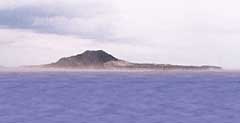
|
|
Pampa Aullagas at the southern end of Lake Poopo, high in the Bolivian Andes. In the wet season, Pampa Aullagas becomes an island,
looking much like the central city of Atlantis as described by Plato. Allen believes that the record of the sinking of Atlantis
is a memory of the severe flooding this region occasionally suffers.
Image from
Jim Allen's Historic Atlantis in Bolivia.
|
Recently an interesting solution to the Atlantis question has been put forth. Bolivia, or "Atlantis in the Andes", has been chosen as the
location of Atlantis by author James Allen, who believes that the whole of South America is that lost continent, and that the Pampa Aullagas,
a low mountainous area high in the Bolivian Andes at the south end of Lake Poopo, was once its capitol. Despite the unlikelihood of this
premise at first blush, Allen makes some very powerful arguments, including the fact that the Pampa Aullagas is shaped much like the central
city described by Plato, with rings of earth alternating with rings of water. Also, nearby is the Bolivian Altiplano, a very large, high
plain, which is a very good match for the "rectangular and oblong" plain described by Plato that served as the breadbasket of Atlantis. Yet
another excellent correlation is the abundance of gold, silver, copper, tin and orichalcum in the Andes, a combination of metals which
is very rarely found in the same place, orichalcum being particularly rare.
It was not the continent of Atlantis which sank into the sea, but the island capital of the same name, built around a
volcanic island which sank into the inland sea of Lake Poopo which exists on the edge of the rectangular plain presently called the
Bolivian Altiplano. This plain is in the centre of the continent exactly as Plato described it. Modern satellite mapping shows it to
be of rectangular configuration, perfectly level, enclosed on all sides by mountains and these mountains contained the metals gold,
silver, copper, tin and the mysterious "Orichalcum" (an alloy of gold and copper which occurs only in the Andes) which Plato said
were used to plate the walls of the circular city. The words "Atl" and "Antis" are themselves of native America origins meaning
"water" and "copper" respectively and the plain is subject to earthquakes and floods such as Plato said sank the city in a single
day and night of rainfall.9
The combination of factors, including the shape of the Pampa Aullagas, the nearby Bolivian Altiplano, and the presence of the rare
orichalcum and numerous other precious metals make for a very strong argument in favor of Atlantis in the Andes. Cayce, however, believed the
the area around Bolivia, Peru and Chile, what is now western South America, was actually a colony of Atlantis, rather than being Atlantis
itself. Moreover, the orichalcum could have easily been mined and shipped back to Atlantis to be used there — the presence of orichalcum
in a particular area does not mean that it could only be used on buildings in that area. Plato's description also makes it clear that the
trip to Atlantis from the Mediterranean was relatively easy, and that Atlantis was also a convenient waypoint to the lands beyond, which
could only have been North, South and Central America. Most likely the solution to this problem is that the inhabitants of ancient Bolivia,
the Inca and their predecessors
— some of whom had probably emigrated from Atlantis after the island began to sink — sought to emulate the successful techniques
that were used by the Atlanteans.

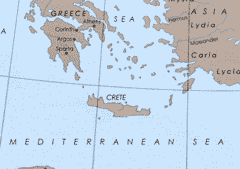
|
|
A closeup of a map of the eastern Mediterranean. Some theorists believe that Atlantis was located on the island of Thera, near the main
island of Crete, but Crete is clearly too small, and was very familiar to the Greeks. Even more, Solon probably passed near
Crete on the way to Egypt, or even stopped over there, as it is directly between the Greek Islands and Egypt.
Image from
Plato and His Dialogues: "Map of Eastern Mediterranean".
|
Another well-argued theory is the theory that Crete, specifically, the island of Thera, was the site of legendary Atlantis.
The island of Thera (also known as Santorini) is part of a group of islands known as the Cyclades in the Mediterranean.
Thera remains today an active volcano, though how it appears to us now is much different than it would have looked before
the massive eruption about 1628 BC. When Thera erupted it utterly destroyed the island including the city of Akrotiri,
burying it under tons of ash and debris. The entire center of the island was blown away and where there was once a mountain
peak it was now flat ocean. Geologists consider the eruption of Thera to be the most massive and singularly destructive
event in recorded history.10
Don Allen in his page,
"
Was Plato's Atlantis a Memory of Minoan Civilization?",
describes how the Minoan civilization was very similar to that described in Plato's Dialogues. Proponents of this theory also point
out a possible mistranslation of Plato's timeline for Atlantis, saying that that the symbol for "100" is similar to "1,000", making it
possible that Plato's Atlantis preceded the time of Solon, around 600 b.c., by 900 years instead of 9,000 years. That would make the
destruction of Atlantis around 1500 b.c., which could correspond with the destruction of the city of Akrotiri on the island of Thera
by a volcanic eruption that occurred around 1628 b.c.
Though the arguments in favor of Thera being legendary Atlantis are intriguing, Crete was well known to both the Greeks and the Egyptians
before and since the time of Solon, and is far smaller than the island described by Plato. Moreover, it is not in the Atlantic, west of
the Pillars and, most importantly, the island never sank. So, Thera is clearly not the site of legendary Atlantis.

A more recent entry into the Atlantis arena is the discovery of underwater ruins off the shore of Mahabalipuram in Tamil Nadu, South India.
This discovery was the latest in a series of discoveries made by
The India-Atlantis Expedition
that started in March of 1991, when "marine archaeologists from India's National Institute of Oceanography (NIO) discovered a massive structure
75 ft deep in the Bay of Bengal, about five kilometers off the coast of Poompuhar in south-east India".11
Since 1999, noted author Graham Hancock, who recently published a seminal work on the subject,
Underworld: The Mysterious Origins of Civilization,
has developed a hypothesis that the dramatic rise in ocean levels at the end of the Ice Age had submerged many of the ancient temples and
historical sites that are mentioned in Indian myth and legend but have since been lost:
Hypothesis: The Indus-Sarasvati civilization, the development of which archaeologists have already traced back 9,000 years, has an earlier
episode of hidden prehistory. It was founded by the survivors of a lost Indian coastal civilization destroyed by the great global floods
at the end of the Ice Age. Such floods occurred many times between 15,000 and 7,000 years ago.... The survivors were experienced
farmers, as the archaeological record confirms, and their cultural level was high, but religious and philosophical considerations
(perhaps even a reaction to the supposed "judgment" of the flood on their former lifestyle?) led them to create a sparse, utilitarian and
ascetic new world — even as they moved gradually towards ever larger and more complex urban communities. There were secular rulers but
the real leadership of the new communities remained vested down the generations in the brotherhood of sages whose forefathers had escaped
the deluge — the lineage of Vedic masters whose task it was to preserve and transmit a precious body of antediluvian
knowledge.12
Atlantis of course, as we have seen, is clearly linked to the Atlantic by all the extant literature on the subject, so the idea of an
"India-Atlantis" is likely more a common means of gaining attention for a truly remarkable find than the true belief that Atlantis might
be found off the shores of India.
There has been some talk in alternative history circles, however, of an ancient antediluvian empire known as Rama, which is believed by
some to have once ruled the area that these men have uncovered. Another possibility is that it was part of the lost continent of Lemuria,
but that is yet another story for another time.

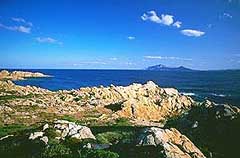
|
|
Sardinia, a large island 120 miles west of Italy, is believed by some to be the site of legendary Atlantis. However,
though like Santorini, cultural similarities can be seen, the size, location and geography are still substantially
different than that described by Plato.
Image from
Atlantis Discovered: "Thesis".
|
Sunny, exotic Sardinia has also been proposed as a potential location for Atlantis. Located west of both Greece and Egypt, Sardinia was a
militarily powerful state between 2000 and 1400 b.c. This fits into the same time period
suggested above
as the island of Santorini in Crete, where if one changes 9,000 years to 900 years, the actual time of the destruction of
Atlantis was around 1500 b.c. Robert Ishoy explains his thesis in
Atlantis Discovered:
My hypothesis is that Atlantis was a powerful state that was based on the island of Sardinia in the Western Mediterranean Sea. This
powerful state was most fully developed in the pre Bronze Age and the early Bronze Age, say about 2000 BC to 1400 BC. These dates are
supported by A. G. Galanopoulos' adjustments to Plato's time period for Atlantis. It is also my belief that Atlantis controlled much of the rim of the Western Mediterranean and
even made attempts to conquer the highly developed states of the Eastern Mediterranean including; Mignon Crete, early Hellenes Greece
and Egypt. This would mean that Atlantis was primarily a sea power. Perhaps the earliest great sea power in history. But according
to Plato Atlantis was defeated in their invasion attempt of the East by a combination of the Athenian navy and major earthquakes and
floods. Together these forces lead to the destruction of Atlantis as a major power. The defeat of Atlantis caused a major set back
in the development of the cultures of the Western Mediterranean. However with new research the history of the Western Mediterranean
may prove to be much richer than previously thought.13
Again, though interesting, the Sardinia theory does not fulfill the primary criteria set forth by Plato and corroborated by Cayce: a very
large continent in the Atlantic Ocean, west of the Pillars of Hercules. Also, Sardinia was never powerful enough to pose a serious threat
to either Greece or Egypt, let alone both Greece, Egypt and all of Europe and Asia, and furthermore, Sardinia never sank. Despite this,
Atlantis-themed
hotels
and
boat tours
are available on the island and in nearby Sicily.
Having analyzed all of the major theories on the location of legendary Atlantis, and also some minor ones, we have found all of them to
be unsatisfactory in one way or another. The Caribbean, though it definitely played an important role in Atlantean history, was not Atlantis,
but one of its colonies. Antarctica is, of course, obviously not Atlantis, though it might host its own interesting antediluvian civilization.
Bolivia, surprisingly, emerges as one of the best candidates in the group we have looked at so far, as it incorporates many of the major
geographical and cultural features described by Plato, though it too is an imperfect match. Crete and Santorini are both islands that
were inhabited since ancient times with cultural histories that were similar to that described by Plato, but neither were ever large or
powerful enough to match the descriptions of Atlantis, and neither are located in the place where Plato placed Atlantis. The India-Atlantis
theory, of course, is so unlike the Platonic account that it does not need further discussion, but it is interesting enough to merit some
attention, if only to learn that there was more to the antediluvian world than just Atlantis.
So what's left? Is there a single location on Earth that matches the classical Platonic and Caycean accounts of Atlantis? Is there an
appreciable land mass in the Atlantic, or some sort of remnant of same west of the Pillars of Hercules, that could be seen as the remnants of
legendary Atlantis? In fact, there is — exactly where Plato described it.

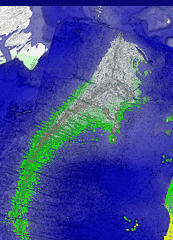
|
The Azores Plateau section of the
antediluvian world map
in false color showing relative altitude based upon the spectrum, dark blue being the lowest elevation and red being the highest.
The Azores are a chain of islands, actually the peaks of underwater mountains on the northern side of the plateau, that run over the
mid-Atlantic ridge
just west of the pillars of Hercules, exactly in the location that Plato described the island of Atlantis.
Image courtesy Wolter Smit,
Was This Atlantis?
|
Plain as day, 1/3 of the way between the Pillars of Hercules and the Americas, is a vast, raised underwater plateau that runs over the highly
unstable
mid-Atlantic ridge.
In the center of this vast, raised underwater plateau is a huge mountain chain. This mountain chain, though it once kissed the sky in the
midst of the Atlantic Ocean, has since been humbled by earthquake and Flood, and is now reduced to a small chain of islands now known as the
Azores.
The Azores are the last bits of the island of Poseidia which,
according to Cayce,
was the last of the Atlantic islands to sink beneath the waves. This was the Atlantis of Plato, the great island "larger than
Libya and Asia put together", that had once terrorized the entire world. Though it is not currently known whether or not this
submarine plateau has the cultural, mineralogical and zoological contents that Plato described, it does fulfill all of the geographical
characteristics laid out by Plato's
Timaeus
and
Critias
(see
Summary)
and generally corroborated by Edgar Cayce, to wit:
 It Is Located in the Middle of the Atlantic: "these histories tell of a mighty power which unprovoked made an expedition against
the whole of Europe and Asia, and to which your city put an end. This power came forth out of the Atlantic Ocean". The Azores are located
1,000 miles west of the Pillars of Hercules, roughly 1/3 of the way across the Atlantic Ocean;
It Is Located in the Middle of the Atlantic: "these histories tell of a mighty power which unprovoked made an expedition against
the whole of Europe and Asia, and to which your city put an end. This power came forth out of the Atlantic Ocean". The Azores are located
1,000 miles west of the Pillars of Hercules, roughly 1/3 of the way across the Atlantic Ocean;
 It Lies West of the Pillars of Hercules: "This power came forth out of the Atlantic Ocean, for in those days the Atlantic was
navigable; and there was an island situated in front of the straits which are by you called the Pillars of Heracles ... for this sea which
is within the Straits of Heracles [the Mediterranean] is only a harbour, having a narrow entrance". The Azores are due west of the
Pillars;
It Lies West of the Pillars of Hercules: "This power came forth out of the Atlantic Ocean, for in those days the Atlantic was
navigable; and there was an island situated in front of the straits which are by you called the Pillars of Heracles ... for this sea which
is within the Straits of Heracles [the Mediterranean] is only a harbour, having a narrow entrance". The Azores are due west of the
Pillars;
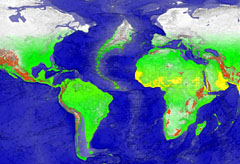
|
Atlantis in its antediluvian context. Larger than Libya and Asia (modern Turkey) combined, Atlantis once dominated the
North Atlantic, occupying a central location which made it an ideal location for the administration of Earth.
Image from
Was This Atlantis?
|
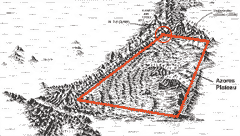
|
The topography of the Atlantic Plain under and around the Azores, from Zhirov's
Atlantis: Atlantology - Basic Problems.
The red rectangle indicates the level plain, "of an oblong shape" in Atlantis that was surrounded on the north and west by high
mountain ranges, as it is here. The Azores islands are the tops of the highest mountains on the north of the plain. Note the location
of the major (7.6) earthquake of 1968 (circled at the northwest corner of the plain) — Hutton believes that this was the
fulfillment of the prophecy of Cayce that Atlantis would begin to rise again in 1968.
Image adapted from
The Hutton Commentaries
|
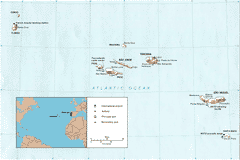
|
A modern map of the Azores islands. These island sit atop a vast submarine plateau which is a perfect match for Plato's Atlantis.
These are the same islands that President Bush, Prime Minister Blair, and President Aznar went for the
Azores Summit
before the Iraq invasion of 2003. Click the image for a larger version.
Image from
University of Texas Online
|
 Its Size Matches that Described by Plato: "the island was larger than Libya and Asia put together" Asia, or "Asia Minor" is now
known as Turkey, and the land mass shown in the topographic map (above and right) is approximately the same land mass as Libya and
Turkey;
Its Size Matches that Described by Plato: "the island was larger than Libya and Asia put together" Asia, or "Asia Minor" is now
known as Turkey, and the land mass shown in the topographic map (above and right) is approximately the same land mass as Libya and
Turkey;
 It Is a Convenient Waypoint between the Pillars and the Americas: "[Atlantis] was the way to other islands, and from these you might
pass to the whole of the opposite continent which surrounded the true ocean". In fact, all shipping lanes between the Mediterranean and the
Americas pass through or near the Azores, which are the major mid-Atlantic waypoint even today, where ships can resupply without
having to travel an additional 2,000 miles further;
It Is a Convenient Waypoint between the Pillars and the Americas: "[Atlantis] was the way to other islands, and from these you might
pass to the whole of the opposite continent which surrounded the true ocean". In fact, all shipping lanes between the Mediterranean and the
Americas pass through or near the Azores, which are the major mid-Atlantic waypoint even today, where ships can resupply without
having to travel an additional 2,000 miles further;
 The Western, "Sea" Side of the Plateau is Mountainous: "The whole country was said by him to be very lofty and precipitous on the side
of the sea". The "side of the sea" is the side facing the greater part of the Atlantic Ocean, which is to the west. The Azores plateau
has a mountain chain all the way down its western side, becoming the Lesser Antilles islands and stretching nearly to South America;
The Western, "Sea" Side of the Plateau is Mountainous: "The whole country was said by him to be very lofty and precipitous on the side
of the sea". The "side of the sea" is the side facing the greater part of the Atlantic Ocean, which is to the west. The Azores plateau
has a mountain chain all the way down its western side, becoming the Lesser Antilles islands and stretching nearly to South America;
 It Has a Large Plain Surrounded by Mountains on the North and West: "The whole country was said by him to be very lofty and precipitous
on the side of the sea, but the country immediately about and surrounding the city was a level plain, itself surrounded by mountains which
descended towards the sea; it was smooth and even, and of an oblong shape, extending in one direction three thousand stadia, but across the
centre inland it was two thousand stadia. This part of the island looked towards the south, and was sheltered from the north." The Azores
plateau is basically a flat plain with mountain ranges on the north and west side of the plain. There are some scattered mountains interrupting
the plain, but these might have been created up by the tectonic and/or volcanic action that accompanied the destruction of Atlantis;
It Has a Large Plain Surrounded by Mountains on the North and West: "The whole country was said by him to be very lofty and precipitous
on the side of the sea, but the country immediately about and surrounding the city was a level plain, itself surrounded by mountains which
descended towards the sea; it was smooth and even, and of an oblong shape, extending in one direction three thousand stadia, but across the
centre inland it was two thousand stadia. This part of the island looked towards the south, and was sheltered from the north." The Azores
plateau is basically a flat plain with mountain ranges on the north and west side of the plain. There are some scattered mountains interrupting
the plain, but these might have been created up by the tectonic and/or volcanic action that accompanied the destruction of Atlantis;
 It Is Submerged: "But afterwards there occurred violent earthquakes and floods; and in a single day and night of misfortune ... the
island of Atlantis ... disappeared in the depths of the sea". During the Ice Age, much more of the Azores were above water. Combined with a
reduction of volcanic pressure under the continent, which Cayce argued was the primary cause of the sinking of Atlantis, it is clear that
this plateau was once a mid-Atlantic continent.
It Is Submerged: "But afterwards there occurred violent earthquakes and floods; and in a single day and night of misfortune ... the
island of Atlantis ... disappeared in the depths of the sea". During the Ice Age, much more of the Azores were above water. Combined with a
reduction of volcanic pressure under the continent, which Cayce argued was the primary cause of the sinking of Atlantis, it is clear that
this plateau was once a mid-Atlantic continent.
So, based upon our analysis, the Azores are the most likely candidate for Atlantis — specifically, the island of Poseidia. Currently, only a
few mountaintops of the original mountain range are still above water, but before the end of the last Ice Age, much more was above water.
Magma pressure may have also been reduced for various reasons, causing the Azores to sink, and what is now the British Isles, western
France and perhaps parts of Africa and the Americas to rise to the position they are in today.

Alas Atlantis! Ancient fount of a thousand tales, still she lies sleeping beneath the ocean waves, waiting for her time to rise again. If
but half of what has been written about her is true, Atlantis was at once wonderful beyond imaginings, and wicked beyond redemption.
Fêted by Plato, reviled, unnamed and unwanted in the Bible, yet described in cunning detail by Cayce, Atlantis emerges as a microcosm
of the human condition, of the best and worst mankind has to offer.
All together, all the references in Plato, the Bible and Edgar Cayce make it clear that Atlantis was at once both the center and the ruler
of the antediluvian world. Sitting in the middle of the Atlantic, Atlantis had easy access to both the eastern and the western hemispheres.
She likely controlled world trade with her powerful navy, dominated the world with her technologically advanced armies, and nearly conquered
the world with her boundless ambitions.
The kings of Atlantis were no mere mortals, but giants, both physically and intellectually, semi-divine beings that considered puny mankind
to be fodder for their totalitarian ambitions. These children of Belial tried to destroy the perfect seed that God had created, the Sons of
the Law of One, but failed, due to the endless, bloody warfare with their other giant brethren around the world, the greatest of which,
according to Plato were the Athenians. The Athenians were likely also giants, the offspring of the goddess Athene, which explains why they
were able to defend against the Atlanteans where all else had failed.
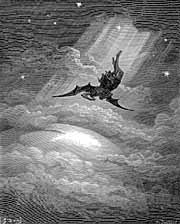
|
"I saw Satan fall like lightning from heaven."
(
Luke 10:18)
"And there was war in heaven: Michael and his angels fought against the dragon; and the dragon fought and his angels,
And prevailed not; neither was their place found any more in heaven.
And the great dragon was cast out, that old serpent, called the Devil, and Satan, which deceiveth the whole world: he was cast out
into the earth, and his angels were cast out with him.
And I heard a loud voice saying in heaven ... 'Woe to the inhabiters of the earth and of the sea! for the devil is come down unto you,
having great wrath, because he knoweth that he hath but a short time.'"
(
Rev. 12:8-10, 12)
"The fifth angel sounded his trumpet, and I saw a star that had fallen from the sky to the earth. The star was given the key to the
shaft of the Abyss. When he opened the Abyss, smoke rose from it like the smoke from a gigantic furnace. The sun and sky were
darkened by the smoke from the Abyss."
(
Rev. 9:1-2)
Image from
Dore's Illustrations for "Paradise Lost".
|
These semi-divine giants were the descendants of a mysterious race of divine beings who, in the earliest times of Earth's history, had come
down to Earth in order to rule over it. These "fallen angels" had created a race of proto-humans, some of which were gigantic in size, as a race
of workers that they used to accomplish this task. God, who was in conflict with these fallen angels, did not want this, and created Adam
— man as we know him today — in order to destroy and replace the inferior and wicked creations of the fallen angels. However, instead
of destroying the creations of the fallen angels, Adam and Eve instead were apparently enticed into intermarrying with them. In this
interpretation, the two "trees" in the Garden of Eden account were not literal trees, but symbolized the two different DNAs of these two
divergent races of mankind. Thus, by interbreeding with the giants, symbolically "eating the apple" from "The Tree of the Knowledge of Good
and Evil", Adam and Eve spoiled their pure genetic seed, "The Tree of Life", by mixing it with that of the inferior creations of the fallen
angels. As a result, they and their descendants were estranged from God, as they were now consorting with God's enemies, the fallen angels and
their giant offspring, the nephilim. Ever since that time, these "two seeds", "the seed of the woman", and "the seed of the
serpent", have struggled for dominance over the Earth, used as proxies in the ongoing war between God and the fallen angels.
For a time these two seeds, whom Cayce referred to as the Sons of the Law of One and the children of Belial, dwelt together in relative peace
on the island of Atlantis and elsewhere,
apparently intermarrying with each other even though this had been forbidden by God. Together they developed a high degree of technological
prowess, to the point where they could travel equally well by air, land or sea, transmit information over long distances, and also transmit
energy over long distances, either for constructive or destructive purposes, much like today. Whereas for a time the children of Belial dwelt
peaceably with the Sons of the Law of One, their lust for power soon took over, and they separated from the Sons of the Law of One and began
to focus more and more on developing military technologies in order to conquer the world. Refusing to cooperate, the Sons of the Law of One
began to emigrate to colonies around the world, using their technology to help mankind, instead of enslaving and destroying them as the
children of Belial sought to do. The children of Belial developed their technologies to the point where they could actually tap into the
volcanic forces deep beneath the earth, and developed methods of causing earthquakes in diverse places in order to discomfit their enemies.
This also weakened the magma pressure beneath the island of Atlantis, however, and as a result, much of the island sank beneath the waves of
the Atlantic. This was the First Great Destruction of Atlantis.
Thousands of years passed as the Atlanteans rebuilt their shattered civilization, and the children of Belial repented of their warlike ways for
a time. However, over thousands of years memories of the First Destruction of Atlantis faded, and the children of Belial again tried to take
over the world, causing the the Second Great Destruction of Atlantis, around 50,000 b.c. Many thousand of years passed, and the children of
Belial took more care in handling their technology until around 9500 b.c., when their warmaking resulted in the Third Great Destruction of
Atlantis, when the remaining islands of Atlantis sunk below the waves.
This final destruction was not completely the result of the world war that was raging just before the Flood, however.
Apparently God saw that it was necessary to intervene before the Earth became so polluted that it would become uninhabitable. The Earth,
already greatly polluted by the weapons of the Nephilim — which Cayce intimated were nuclear in nature — had to be cleansed,
so God sent a Flood to destroy and bury the antediluvian world, save a precious few of the Law of One that were still genetically pure. God
accomplished this by sending an angel to Noah with instructions on how to build an ark and, once this was accomplished, he instructed the
archangels to hurl rocks down on the Earth, destroying Atlantis and Athens "in a single day and night". These massive asteroids, besides
causing massive earthquakes, caused huge tidal waves to drown the coastlands and also threw up massive amounts of water into the atmosphere,
which rained down over the entire earth for 40 days and 40 nights. As a result, the entire surface was flooded for 150 days, and the entire
antediluvian world was buried under hundreds of feet of sediment — purified from the pollution of the Nephilim and from the
Nephilim themselves. Only Noah and his family survived to repopulate the Earth, though the spirits of the dead Nephilim, it is
said, still roam the Earth, tormenting mankind. And what happened to the fallen angels? The archangels had been ordered to specifically
target them with the huge rocks they threw down on Earth, burying them in the low places of the Earth, the abyssal plains underneath the
oceans — exactly where the Azores — the remnants of legendary Atlantis — are located.
This brings us full circle in our study of legendary Atlantis. Cayce and others have said that Atlantis would one day rise again, at the time
of the end when the Pyramid of Records near the Sphinx would be opened and the records of Atlantis' history from the foundation to its final
destruction would be revealed. Cayce makes it clear, however, that the Pyramid of Records cannot be opened until Atlantis rises. To this end,
at the time of the end the Bible says that an angel that had fallen to earth — one of the fallen angels who had created the Nephilim
— would be given the key to the Abyss which, according to the Book of Enoch, is where the angels Semjaza and Azazel had been buried by
the archangels. This, is course, refers to the Mid-Atlantic Ridge, the
lowest place on Earth,
over which the Azores are located. Obviously, the Abyss, which is also associated with the deep sea in the biblical accounts, is the
mid-Atlantic ridge, specifically, the area around the Azores plateau, which we have determined was the site of legendary Atlantis. Therefore,
the fallen angel will be allowed to raise Atlantis once more.
Somehow, Atlantis, the Sphinx, and the Apocalypse are all inextricably linked. But what is the "key"? We know that the war between God and
the fallen angels will break out again into open warfare at the time of the end, as it is clearly outlined in the Book of Revelation. At this
time, God once again will direct the archangels to hurl rocks down upon wicked mankind, just as he did at the time of Noah, when the
Nephilim were running rampant and polluting and destroying the Earth. When Jesus described how things would be at the time of the end,
saying "As it was in the days of Noah, so it will be at the coming of the Son of Man". (
Matt. 24:37), he knew that the Nephilim would be on the Earth again, up to their old tricks, giving man technology so that they
could fight one another. However, this time, one group will be allowed to win and take over the Earth for a period of time, as this time
God is coming to Earth to take over for good, and permanently imprison the fallen angels. The fallen angels will therefore work together to
provide a unified defense. To accomplish this, just before the Apocalypse, mankind will be raised to a high level of technology in order
to create "wonder weapons" that the fallen angels will use in a desparate last-ditch defense against the Second Coming. It is no coincidence
that the Book of Revelation is rife with descriptions of world war, and of rocks thrown down to earth by the archangels, as they had done it
once before, at the time of Noah.
So here we are, at a time of high technology, at the brink of world war, when the Nephilim appear to be on Earth once more. Soon,
perhaps already, the final conquest and consolidation of Earth will begin once again, accomplished with wonder weapons of a technology level
not seen on Earth since before the Flood. Already some areas of the Earth that may hold the key to unlocking Atlantis — and the
not-so-pleasant characters that were buried with it — have been liberated. Perhaps a latter-day Nimrod will arise and find the key to
unlock the secrets of Atlantis, and the details about humanity's origins. That day may be a day of great hope and enlightenment — or
perhaps a great day of fear and terror, the likes of which the world has not seen since the
beginning. One thing is for sure, for good or for ill, Atlantis is rising again.
The Legend of Atlantis Part I: Atlantis in History
Part II: The Antediluvian World
|
Part III: Edgar Cayce's Atlantis
Atlantis: Retrospective
|
Atlantis: The Theories
|
Atlantis: The Azores
|
Atlantis Rising
Atlantis Links
|
Atlantis Books
Editorial
|
Press Releases
|
Book Reviews
|
Fragments
Effigy Mounds II
|
Sea Serpents IV
|
Atlantis IV
Register
for our new Hall of Records Newsletter!
Questions? Comments? Suggestions? Advertising? Press Releases?
Contact us!




 Was This Atlantis?
Was This Atlantis?
 Atlantis Rising Magazine
Atlantis Rising Magazine
 Plato: Timaeus & Critias
Plato: Timaeus & Critias
 Atlantis: Vital Statistics
Atlantis: Vital Statistics
 Atlantis Revealed
Atlantis Revealed
 About.com: Atlantis Theories
About.com: Atlantis Theories
 University of Iowa: Briefing on Lost Continents
University of Iowa: Briefing on Lost Continents
 ThinkQuest: The Legend of Atlantis
ThinkQuest: The Legend of Atlantis
 Atlantis Reviews
Atlantis Reviews
 Atlantis - The Lost Continent Finally Found
Atlantis - The Lost Continent Finally Found
 The Museum of Unnatural Mystery: Atlantis
The Museum of Unnatural Mystery: Atlantis
 Atlantis History: Descendants of the Legendary Lost Continent of Atlantis
Atlantis History: Descendants of the Legendary Lost Continent of Atlantis
 The Skeptic's Dictionary: Atlantis
The Skeptic's Dictionary: Atlantis
 Crystal Links: Atlantis: Ancient Writings and Theories
Crystal Links: Atlantis: Ancient Writings and Theories
 Brian Taylor: Atlantis
Brian Taylor: Atlantis
 Atlantis Rising: Forums
Atlantis Rising: Forums
 ATLANTIS: Ice Age Civilization
ATLANTIS: Ice Age Civilization
 Atlantide Home
Atlantide Home

 Azores Tourist Information
Azores Tourist Information
 Azores Online
Azores Online
 Eurosun Holidays: The Azores
Eurosun Holidays: The Azores
 Azores.com
Azores.com
 Portugal Travel Guide: Azores
Portugal Travel Guide: Azores
 Travel Pictures: Azores Islands
Travel Pictures: Azores Islands
 Virtual Azores
Virtual Azores
 Culture Connect: Azores Islands
Culture Connect: Azores Islands

 Atlantis Insights: Atlantis in the Caribbean
Atlantis Insights: Atlantis in the Caribbean
 Atlantis: Insights from a Lost Civilization
Atlantis: Insights from a Lost Civilization
 Crystal Links: Atlantis, Lost City Found Off Cuba
Crystal Links: Atlantis, Lost City Found Off Cuba
 Morien Institute: Advanced Digital Communications Interview
Morien Institute: Advanced Digital Communications Interview
 Mysterious World: Atlantis Off Cuba?
Mysterious World: Atlantis Off Cuba?
 Atlantis in America: Navigators of the Ancient World
Atlantis in America: Navigators of the Ancient World
 Cuba versus Hispaniola � The Atlantis Debate Continues
Cuba versus Hispaniola � The Atlantis Debate Continues
 The Millennium Matters: Atlantis and the Bermuda Triangle Fragment
The Millennium Matters: Atlantis and the Bermuda Triangle Fragment

 When the Sky Fell
When the Sky Fell
 BrianTaylor.com: Atlantis: Where is the Lost Continent?
BrianTaylor.com: Atlantis: Where is the Lost Continent?

 Jim Allen's Historic Atlantis in Bolivia
Jim Allen's Historic Atlantis in Bolivia
 Jim Allen's Historic Atlantis in Bolivia: Atlantis Trail Gallery
Jim Allen's Historic Atlantis in Bolivia: Atlantis Trail Gallery
 Magic Bolivia: Atlantis
Magic Bolivia: Atlantis
 South American Pictures: The Bolivian Atlantis
South American Pictures: The Bolivian Atlantis
 Plato and the Bolivian Atlantis
Plato and the Bolivian Atlantis

 The Lost City of Atlantis: The Island of Thera
The Lost City of Atlantis: The Island of Thera
 Santorini and the Legend of Atlantis
Santorini and the Legend of Atlantis
 Atlantis.....Thira?
Atlantis.....Thira?
 Was Plato's Atlantis a Memory of Minoan Civilization?
Was Plato's Atlantis a Memory of Minoan Civilization?
 The Tsunami Page: "The Waves That Destroyed the Minoan Empire (Atlantis)"
The Tsunami Page: "The Waves That Destroyed the Minoan Empire (Atlantis)"
 GreekIslands.com: Crete
GreekIslands.com: Crete
 Explore Crete
Explore Crete

 India-Atlantis Expedition
India-Atlantis Expedition
 Atlantis, The Lost Continent Finally Found: Atlantis in the Indies
Atlantis, The Lost Continent Finally Found: Atlantis in the Indies

 Atlantis Discovered: Thesis
Atlantis Discovered: Thesis
 Sardinia.net
Sardinia.net
 In Italy Online: Welcome to Sardinia!
In Italy Online: Welcome to Sardinia!
 Discover Sardinia
Discover Sardinia
 ItaliaTour! Sardinia
ItaliaTour! Sardinia
 ItaliaTour! Atlantis Bay (Sicily)
ItaliaTour! Atlantis Bay (Sicily)
 Atlantis Charter
Atlantis Charter
 Corsica Ferries/Sardinia Ferries
Corsica Ferries/Sardinia Ferries
 Sardinia Climb
Sardinia Climb

 TravelPiriReis.com
TravelPiriReis.com
 Atlantis Resort
Atlantis Resort
 BlueAegean.com: Atlantis
BlueAegean.com: Atlantis
 TourEgypt.net
TourEgypt.net
 The Rock of Gibraltar
The Rock of Gibraltar
 Gibraltar Rock Tours
Gibraltar Rock Tours
 1 Gibraltar Plaza
1 Gibraltar Plaza
 Choosing Cruising: Morocco
Choosing Cruising: Morocco
 Travel Notes: Morocco
Travel Notes: Morocco


 Timaeus and Critias (Penguin Classics)
Timaeus and Critias (Penguin Classics)
Plato, H.D. Lee (Editor)
The complete text of Plato's Timaeus and Critias dialogues. Always the best place to start for any would-be Atlantean researcher.
Click
here
to buy this book.
 The Atlantis Dialogue : The Original Story of the Lost Empire
The Atlantis Dialogue : The Original Story of the Lost Empire
Plato, B. Jowett (Editor), Aaron Shepard
Atlantis was first introduced to world literature by the Greek philosopher Plato in two "dialogues" he wrote in the fourth century B.C. His tale of a great empire that sank beneath the waves has sparked thousands of years of debate over whether Atlantis really existed. But did Plato mean his tale as history, or just as a parable to help illustrate his philosophy?
In this book, you'll find everything Plato said about Atlantis, in the context he intended. Now you can read and judge for yourself!
(Review by Amazon.com)
Click
here
to buy this book.
 Atlantis: The Antediluvian World
Atlantis: The Antediluvian World
Ignatius Donnelly, Everett F. Bleiler (Editor)
Rating:    
This is the book that started it all, written a century ago by a man as strange and dynamic as his story. Every fantastical image of a sunken paradise, or heated dispute about it's existence and location, all started with these pages. The origin of all Atlantis-hype, this book similarly starts with the origin of the concept itself. Donnely includes a translation of Plato's story that all Atlantean research goes back too. This was the most interesting part of the book, just hearing the first account all discussion and contemplation aside. It is also the most integral part of the book, since out of it comes all of Donnely's extrapolation.
(Review by Amazon.com)
Click
here
to buy this book.
 Atlantis: Insights from a Lost Civilization
Atlantis: Insights from a Lost Civilization
Shirley Andrews
Rating:     
The legend of lost Atlantis turns to fact as Shirley Andrews uniquely correlates a wealth of information from more than 100 classical
and Atlantean scholars, scientists, and psychics to describe the country and its inhabitants.
Click
here
to buy this book.
 Atlantis in America: Navigators of the Ancient World
Atlantis in America: Navigators of the Ancient World
Ivar Zapp, George Erikson
Rating:    
Click
here
to buy this book.
 When the Sky Fell: In Search of Atlantis
When the Sky Fell: In Search of Atlantis
Rand Flem-Ath, Rose Flem-Ath
Rating:   
The fascinating truth about Atlantis leads to a chilling conclusion about the environmental catastrophe that destroyed it. Now you can
find out how the forces that shattered the first great civilization on Earth can happen again, bringing the end of the world to us all!
With an Introduction by Colin Wilson.
Click
here
to buy this book.
 Underworld: The Mysterious Origins of Civilization
Underworld: The Mysterious Origins of Civilization
Graham Hancock
Rating:     
From the author of the bestselling Fingerprints of the Gods comes a fascinating voyage of underwater discovery that will forever change the way we think about the birth of civilization. Fans of
The Sign and the Seal
and
Heaven�s Mirror
will delight in Graham Hancock�s Underworld, his latest work of archaeological detection. In this mesmerizing book, Hancock merges cutting-edge science with historical myth to come up with a new explanation for the origins of civilization as we know it today. At the end of the last Ice Age melting ice caused sea levels around the world to rise by approximately 400 feet, radically changing the shape of the world. Hancock, steeped in the ancient flood myths that speak of early civilizations, sets out to discover whether these myths have any basis in reality. Using the latest computerized "inundation maps" that show the shape of the world�s coastlines as they looked at intervals throughout the meltdown, Hancock finds astonishing correspondences with the ancient flood myths. And, when he starts to explore these areas underwater on several diving expeditions, he actually discovers ruins beneath the sea exactly where the myths say they should be. Hancock offers dramatic accounts of his explorations of the waters of the Arabian Sea, the Mediterranean, and the sea of Japan. This entertaining and provocative book of discovery presents the first hard evidence of these ancient cities, and gives all of us stunning insight into the origins and development of civilization.
(Review by Amazon.com)
Click
here
to buy this book.
 Atlantis: The Andes Solution: The Discovery of South America As the Legendary Continent of Atlantis
Atlantis: The Andes Solution: The Discovery of South America As the Legendary Continent of Atlantis
James M. Allen, John Blashford-Snell (Foreword)
Allen, a former air photo interpreter for Britain's Royal Air Force who has also studied ancient measurements, weighs in here with
another theory concerning the legendary lost continent. Based on Plato's account (reprinted here)
and his own research, which included a trip to South America, Allen argues that the site of Atlantis was on the Bolivian Altiplano
(a series of high plains). Allen's major points rest on rather shaky foundations: the similarity of the Bolivian terrain to the
geographical details in Plato's dialogues; the fact that floods and earthquakes have occurred in the Bolivian Altiplano; and the
fact that precious metals referred to by Plato as mined in Atlantis are also found in Bolivia. This is enjoyable reading, but seems
more an exercise in textual legerdemain than science as Allen relies heavily on his own interpretation of Plato, which makes his
ideas intriguing rather than convincing. Atlantis buffs will want to add this to their shelves, but few readers will be convinced
by the many parallels Allen attempts to draw between the ancient cultures of the Mediterranean and pre-Columbian America.
Click
here
to buy this book.
 Atlantis: Atlantology - Basic Problems
Atlantis: Atlantology - Basic Problems
N. Zhirov
A Soviet scientist examines geology, climate, oceanography and attempts reconstruction of Atlantis. Illustrated with maps, charts, tables,
illustrations, seismic data, sonar images, etc. The author believes that Atlantis existed and uses a great number of facts to back up his
arguments. His work sums up much on what we know about atlantology. This book will unquestionably serve as the basis for elaborating on
many aspects of one of the world�s most dramatic problems. Zhirov was a chemist by trade and a leading Soviet Atlantologist. The book was
written between 1959-63. New data was added for this English edition. Seismics, gravimetrics, climatology, paleobotanical data,
geomorphology, plate tectonics, turbidity data, bottom current patterns, submarine erosion and geological data separate this book from
most of the rest of the Atlantology field. Cites 825 separate sources in 34 pages of references - Russian, Ukrainian, Greek, German,
English, Latin....
Click
here
to buy this book.
 Dore's Illustrations for "Paradise Lost"
Dore's Illustrations for "Paradise Lost"
Gustave Dore
Rating:    
Gustave Dore's romantic style of illustration, imaginative and richly detailed, was ideally suited to literary subjects. His wood-engraved illustrations for John Milton's monumental epic poem PARADISE LOST--recounting mankind's fall from the grace of God through the work of Satan--were among Dore's finest works. This volume presents superb black-and-white reproductions of all 50 plates.
Click
here
to buy this book.
 Gateway to Atlantis: The Search for the Source of a Lost Civilization
Gateway to Atlantis: The Search for the Source of a Lost Civilization
Andrew Collins, David Rohl (Introduction)
Rating:    
Proceeding from the adage that absence of evidence is not evidence of absence, Collins navigates through the ancient and medieval references to Atlantis, of which not an iota of indisputable archaeological evidence has ever surfaced. He restrains credulousness in the text with conditional constructions and never imperatively claims that any particular detail proves Atlantis existed. Read the book on Collins' terms, and he proves an engaging conductor of an exegetical tour of Plato's writings about a civilization on an island in the Western Ocean that colonized bits of Europe but vanished when a natural catastrophe befell its homeland. Collins discounts the proposition that the 1500 B.C. eruption of Thera, which coincided with the decline of Minoan civilization, underlies the Atlantis story. Instead, he fields a blizzard of propositions; these, in a nutshell, propose that a Phoenician colony in Iberia might have had transoceanic contact with the Olmec and other Meso-American civilizations. Accept the what-if-ness of Collins' views, and his book may enamor imaginations sparked by the legend of lost Atlantis. (Review by Amazon.com)
Click
here
to buy this book.
 Lost Cities of Atlantis Ancient Europe & the Mediterranean (Lost Cities Series)
Lost Cities of Atlantis Ancient Europe & the Mediterranean (Lost Cities Series)
David Hatcher Childress
Rating:    
Another installment in Childress' classic "Lost Cities and Ancient Mysteries" series. Covers Europe, the Mediterranean and, of course, Atlantis, tracing the interplay between the cultures of these areas from very ancient to modern times. A cracking good read and a must for any would-be maverick archaeologist.
Click
here
to buy this book.
 The Atlantis Blueprint: Unlocking the Ancient Mysteries of a Long-Lost Civilization
The Atlantis Blueprint: Unlocking the Ancient Mysteries of a Long-Lost Civilization
Colin Wilson, Rand Flem-Ath
Rating:    
Veteran chronicler of history's mysteries Wilson and his cowriter Flem-Ath have come up with a new theory on Atlantis, or at least an expanded version of an old one. An intelligent society (but probably not from outer space), commonly known as Atlanteans, lived in snow-free Antarctica and left a connection of sacred sites that spans the globe. Whether the authors' theory could possibly be true is hard to divine because their evidence is so convoluted, so filled with measurements and math, geometry and geography, that it would take an Atlantean to work it all out. It doesn't help that the authors feel compelled to throw into their discourse everything but the kitchen sink: the Knights Templars, pyramids, even the Shroud of Turin make an appearance. Still, these sorts of books always generate hype and never fail to attract a solid audience. Pair it with James and Thorpe's Ancient Mysteries (1999), which debunks just this kind of treatment.
Click
here
to buy this book.
 The Destruction of Atlantis: Compelling Evidence of the Sudden Fall of the Legendary Civilization
The Destruction of Atlantis: Compelling Evidence of the Sudden Fall of the Legendary Civilization
Frank Joseph, Zecharia Sitchin
All human cultures, from classical and biblical to native North and South American, share the myth of an ancient deluge, often coinciding with a rain of fire from the heavens. What accounts for this shared myth of environmental catastrophe? Now, in The Destruction of Atlantis, author Frank Joseph links this worldwide cultural phenomenon to the story of the lost civilization of Atlantis, which in a single day and night disappeared into the sea in a violent cataclysm. In the most comprehensive account of this legendary island, Joseph provides compelling evidence that Atlantis was at the root of all subsequent human civilizations. Brilliantly refuting years of modern skepticism, Joseph combines evidence from archaeology, geology, astronomy, and ancient lore to locate Atlantis in the context of Near Eastern Bronze Age society at the end of the 13th century B.C. The author seamlessly combines hard scientific evidence with a stunning imaginative re-creation of what it must have been like to walk the streets of Atlantis in its last days. The resulting portrait of a mighty empire corrupted by an overreaching lust for wealth and power offers an important lesson to our own materialistic civilization poised on the brink of ecological disaster.
Click
here
to buy this book.
 Unearthing Atlantis : An Archaeological Odyssey to the Fabled Lost Civilization
Unearthing Atlantis : An Archaeological Odyssey to the Fabled Lost Civilization
Charles R. Pellegrino
In the year 347 B.C., Plato wrote of a miraculous island with hot and cold flowing waters, terraced multi-storied buildings, and "the fairest of all plains." For thousands, of years, the legend of the mysterious vanished "continent" of Atlantis has captivated writers, poets, artists, philosophers, and dreamers. But now Atlantis has been found -- and the truth about its vibrant life and horrific destruction is even more remarkable than the myth. Based on artifacts and evidence uncovered in an ancient buried Minoan city, noted scientist and New York Times-bestselling author bestselling author Charles Pellegrino reanimates an astounding lost civilization and re-creates with explosive power the apocalyptic cataclysm that destroyed their remarkable island metropolis. A brilliant synthesis of historical, literary, archaeological, and geological detective work, here is both the story of the astounding discovery that transformed tale into fact -- and a breathtakinq vision of Atlantis reborn.
Click
here
to buy this book.
Editorial
|
Press Releases
|
Book Reviews
|
Fragments
Effigy Mounds II
|
Sea Serpents IV
|
Atlantis IV
Register
for our new Hall of Records Newsletter!
Questions? Comments? Suggestions? Advertising? Press Releases?
Contact us!
|

